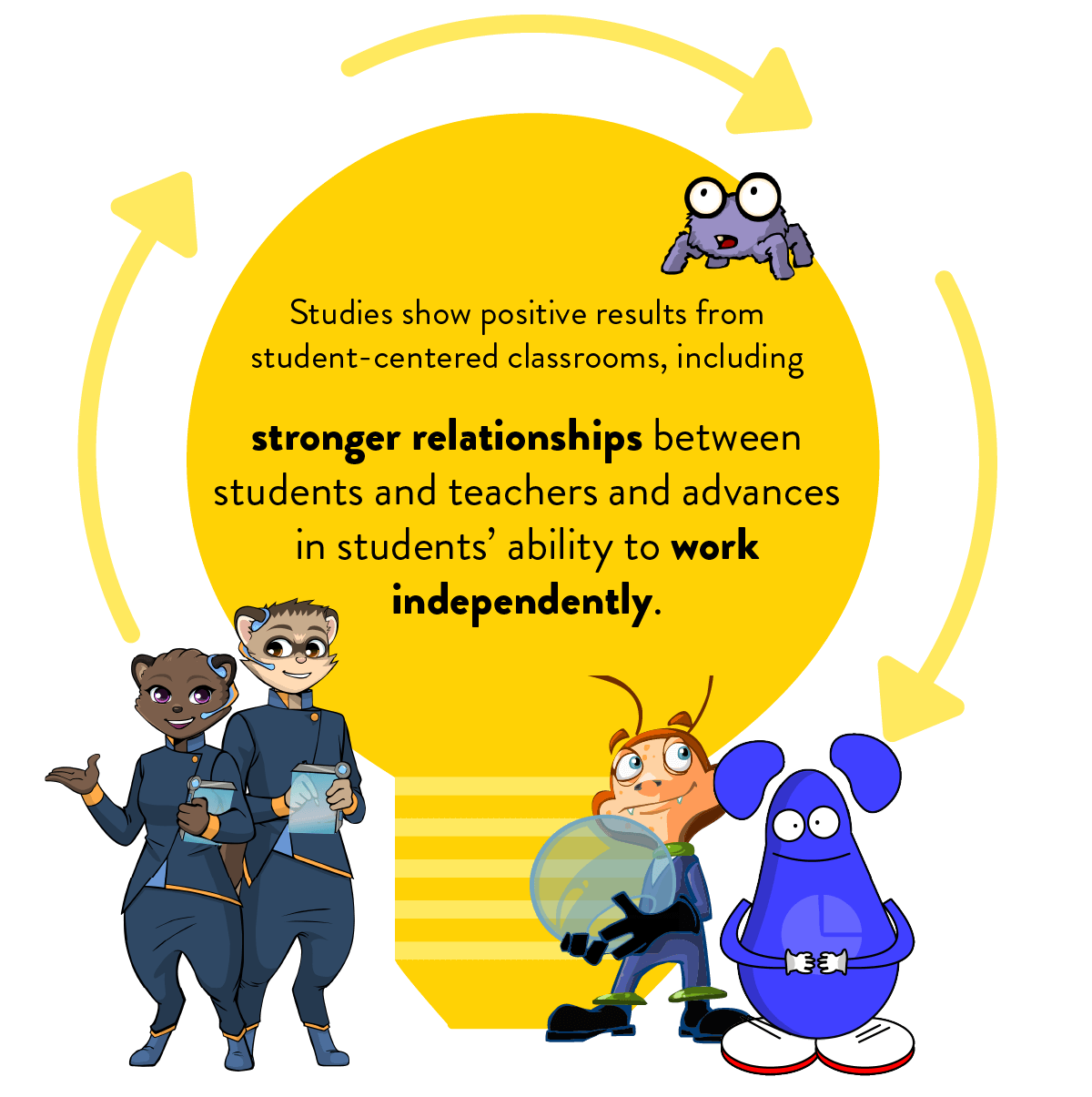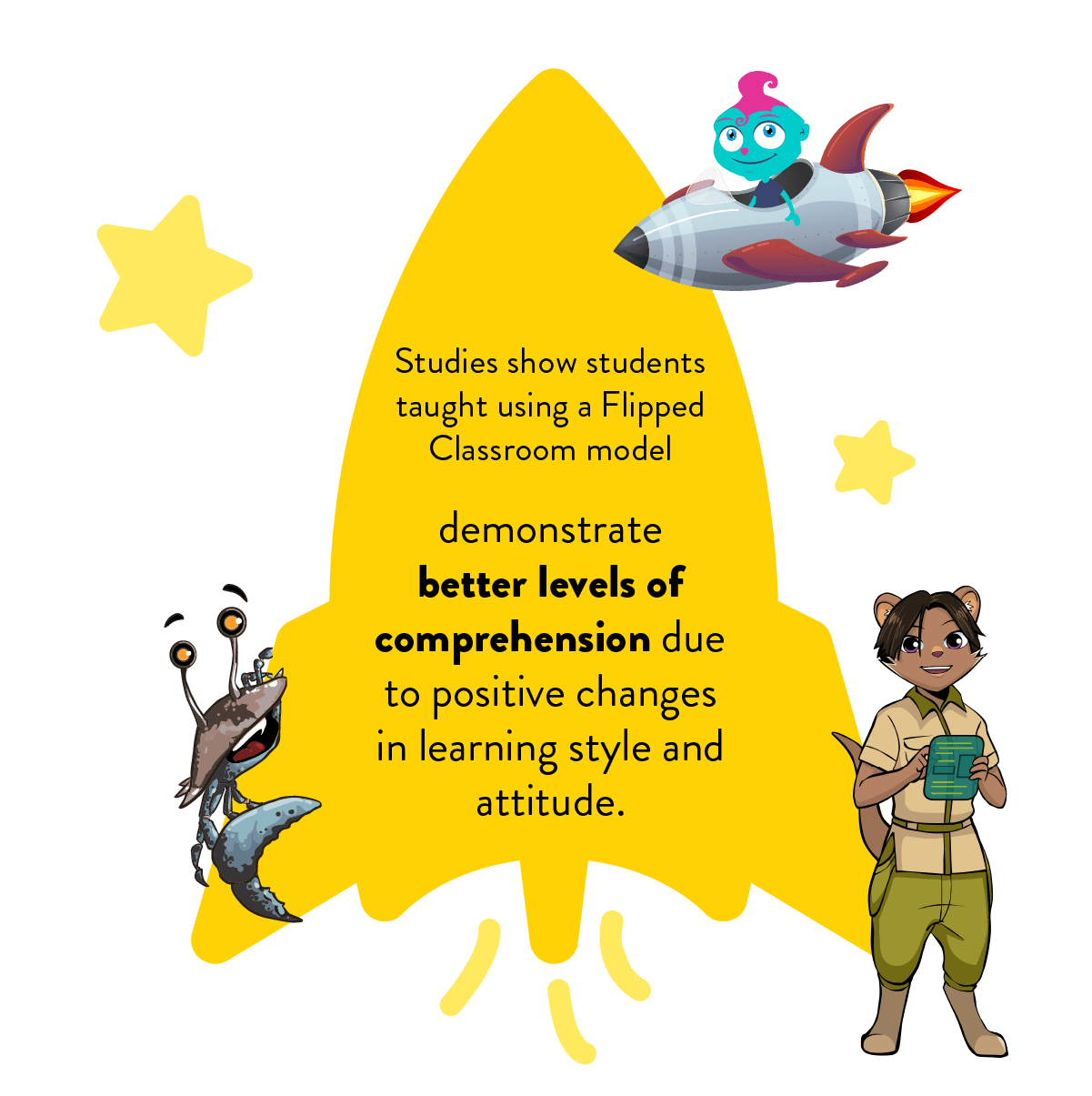6 Effective Strategies for Student-Centered Learning

You’ve heard about student-centered learning. Maybe you even considered trying it in your classroom. But what does it really mean? Read on to learn the definition and benefits of this approach and easy strategies to implement in the classroom!
What is student-centered learning?
Student-centered teaching and learning doesn’t mean a teacher-free environment. Think of it as a shift from teacher-led to student-driven. In fact, the role of a teacher as facilitator is more important than ever. Students must engage and be guided by the teacher for success. The focus is on creating a positive and supportive classroom environment. In this environment, students feel empowered to take risks and take ownership of their learning.
Because it allows for more individualization, student-centered learning puts the learners' needs at the center of the process. For example, during a science project, students choose their own topics of interest, collaborate in small groups to conduct experiments, and present their findings through creative formats like videos, models, or digital posters. It takes flexibility, conversations, and involvement. If that gives the impression of less structured learning, don’t worry! You can take many steps to bring more student-centered learning opportunities into your classroom without losing structure.
Benefits of a student-centered learning environment
A student-centered approach places students at the heart of the educational experience, empowering them to take ownership of their learning through choice, collaboration, and real-world relevance. In the wake of the pandemic, this approach became more important than ever, supporting re-engagement, social-emotional learning (SEL), and academic recovery. It continues to be an essential strategy as educators meet diverse student needs.
Adaptive learning technologies from ExploreLearning, like Gizmos for virtual math and science simulations or Reflex for math fact fluency, allow for personalized strategies to help every learner thrive at their own pace.
If you're interested in creating a student-centered learning environment in your classroom, here are some key benefits to consider:
- Increased engagement: Students become active participants in their learning process, fostering deeper engagement and interest in the subject matter.
- Enhanced critical thinking: Student-centered learning promotes critical thinking skills as students are encouraged to ask questions, explore concepts, and seek solutions independently.
- Personalized learning: Students receive individualized instruction and support, allowing them to learn at their own pace and according to their unique needs and preferences.
- Increases retention: Students actively involved in their learning are more likely to retain information and concepts in the long term.
- Develops autonomy: It cultivates self-directed learning skills, empowering students to take ownership of their education and become lifelong learners.
- Promotes collaboration: Student-centered learning often involves collaborative activities and group projects, fostering teamwork, and communication skills.
- Enables creativity: Encouraging exploration and experimentation stimulates creativity and innovation among students.
- Improves academic performance: Research suggests that student-centered approaches can improve academic performance and overall student success.
6 student-centered learning strategies to try in your classroom
After learning about the benefits of student-centered learning, here are six easy and effective classroom student-centered teaching strategies to implement.
1. Active participation
All teachers want to foster a love of learning. If you want kids to become lifelong learners, involve them. That’s where student-centered learning comes in.
When students have opportunities to make choices and contribute to learning experiences, they gain a sense of partnership with their teacher and classmates. It can be as simple as starting with a K-W-L chart (what do you know, what do you want to know, and what did you learn) or a brainstorming session.
Allow for exploration through a variety of options, including writing, literature, or fine arts. Let them use technology to direct research and design presentations. Bring authentic learning experiences into the classroom that require engagement.
2. Differentiation
No two students are the same, and that’s a wonderful thing. Celebrate differentiated instruction by personalizing the teaching and learning that happens in your classroom. Embrace and include distinct learning needs, interests, cultural backgrounds, and tailor-made goals for success.
Student-centered environments bring individualized purpose, processes, and meaning to learning. Present information in multiple ways, like with infographics or technology. For example, students can work with virtual simulations in Gizmos or master math facts through Reflex. Encourage them to work individually, with partners, or in groups- whatever your students need!

3. Collaboration
Student-centered classrooms are based on collaboration. Students should be encouraged to have constructive conversations. Collaborative projects provide opportunities to strengthen confidence in communication and social and emotional skills. Show kids how to aim for cooperation, not competition, as they work together.
Collaboration may sound noisier than independent practice, but it allows students to work together and support one another. Give them time to plan and talk while processing new information!
4. Questioning and experimentation
All questions are good questions! You may have to begin this process as a whole group to model questioning strategies. Start with knowledge-based questions and move into analysis.
Provide plenty of “think time” as you encourage students to dig deeper with their own questions. Challenge them to experiment with possible solutions. Questioning and experimentation make learning an active process instead of a spectator sport.
5. Stations
These aren’t just for younger students. Stations offer spaces for all ages to participate in student-centered learning.
Because stations let students try out different experiences, learning is not passive! Students are motivated and interested because each station taps into a new skill or fresh information. Get those kiddos out of their seats and move them to stations that provide everything from small group instruction to independent work with technology in the classroom.
6. Flipped classrooms
What does it mean to flip a classroom? When teachers flip learning, they provide readings and video lectures for students to view outside of class or for homework and save active learning for class time. The flipped classroom strategy allows teachers to get a glimpse into students’ thought processes and possible misconceptions before diving into assignments.
Students who struggle with traditional lectures and note-taking thrive because the pressure is off. There’s no need to feel intimidated if they need to move slowly or repeat parts for better understanding. They can go back and retry problems as they begin to comprehend concepts on their own. Students come into class with a basic understanding, questions, and readiness to take their knowledge to the next level.

Real-life student-centered learning examples
Student-centered learning comes to life in classrooms where students engage with content in ways that match their individual needs and interests. How about a few student-centered learning examples to get the ideas started? A middle school science teacher might use Gizmos to allow students to explore simulations at their own pace, deepening their understanding through inquiry-based investigations. In an elementary classroom, students might rotate through small groups using Reflex to work toward personalized math goals, building fluency in a fun and targeted way.
Meanwhile, in a flipped high school biology class, students use Gizmos simulations at home to prepare for hands-on lab work, arriving in class ready to apply their knowledge collaboratively. These snapshots illustrate how adaptive tools and flexible instructional models can make learning more meaningful and effective for every student.
Embrace the journey towards student-centered learning
Moving to student-centered learning may seem a little chaotic in the beginning. Direct instruction has a place in the classroom, too. Don’t feel that you have to abandon direct instruction to create a student-centered learning environment. The two strategies go hand-in-hand to meet the learning needs in your classroom.
Think of it as another way to build a love of learning through questioning, experimenting, and developing critical thinking skills they will use in and out of the classroom! You’ll know what works best for your students, and they’ll get the hang of new procedures.
Why not bring edtech resources on board and give it a try? Whether you hope to build fraction understanding or math fact fluency with elementary students, or take science lessons to the next level for grades K-12, ExploreLearning digital tools make it easy to embrace student-centered learning.
Sign up to get the latest updates from ExploreLearning via occasional email.
